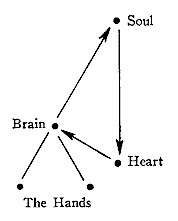| Previous Next Table of Contents |
| Esoteric Healing - Chapter VIII - The Laws and Rules Enumerated and Applied |
We might now take the sentences in this Rule and study their
meaning, as there are more significances in them than appear upon the surface. The first
sentence in each [648] paragraph of this Rule starts with an important injunction to the
healer:
This is the technique of the lowest type of true spiritual healer, and for this reason two of the aspects of the dense physical body are included: the brain and the hands. The healer works, therefore, through a triangle and two lines of energy. The situation can be depicted in the following diagram:
The triangle is completed when the healing work is done and the energy is withdrawn from the hands to the brain again and from thence returned by an act of the will to the soul. When the healer (through practiced alignment) has linked up with his soul, he then draws the soul energy down into his heart center, from whence he transfers it to the brain, where it is definitely focused. Using the ajna center as a distributing center, he then uses his hands as the agency through which the directed energy can reach that area in the patient's body where the seat of the trouble is to be found. He passes the energy into the patient's approximate center which governs the distressed area, from which it [649] permeates the surrounding part of the body, penetrating both to the center of the trouble and to the limits of the distressed area. There are two ways in which he uses his hands, and two methods which he employs:
In the first case, through the laying on of hands, of silent hands, of quiet hands, the energy flow is between the two hands, back and forth within the diseased area; the spinal center is used all the time, and the activity set up, when successful, burns up and absorbs the forces causing the trouble without penetrating the body of the healer. In the second case, the forces are withdrawn by the action of the energy passing through the hands, applied one after the other in a regular time rhythm. They pass through the hands, but are unable to focus themselves there, owing to the concentration of the healing energies within the hands. |
| Previous Next Table of Contents |
